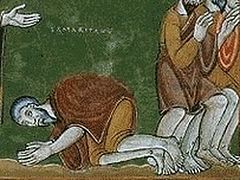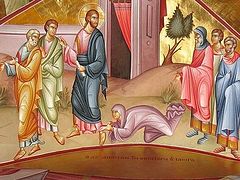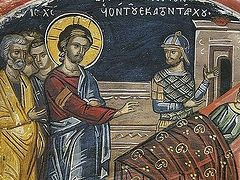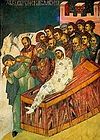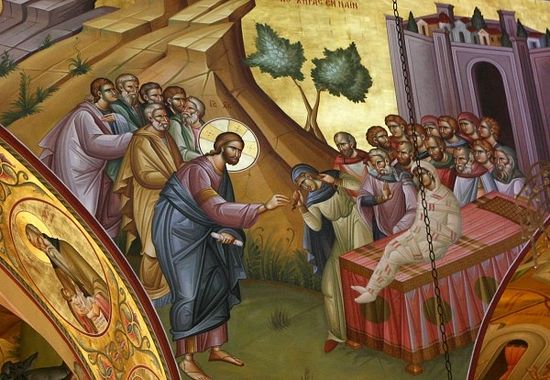
In the Name of the Father and of the Son and of the Holy Spirit.
Today's Gospel concerns the resurrection of the son of the widow of Nain. We recall that this miracle occurred just after the healing of the servant of the centurion, a healing which had taken place at a distance.
We can notice how this miracle of resurrection, like all the Lord's miracles, happened for two reasons.
Firstly, because as the Son and Creating Word and Wisdom of God, Christ in His divine nature, had the power to work miracles, restoring the laws of creation as they had been intended before the Fall, when there was no sickness or death. Through miracles He showed this power, the unique power of the Son of God. In the particular case of the widow, Christ could show His divine power and disprove the rumours which no doubt were already circulating, that the healing of the centurion's servant at a distance had been a mere coincidence - he would have recovered anyway.
Secondly, this miracle happened because as a human-being, Christ in his human nature felt pity and had compassion on those who were suffering. In the particular case of the widow, there was great reason for compassion. In those days a widow was likely to become very poor unless she was looked after by her children. Now the only son of the widow of Nain was the only one who could look after his mother. Without him she would have become destitute, a beggar and perhaps would have died of starvation on the streets.
The miracle of the resurrection of the widow's son was quite unique, unheard of and unseen in human history - only the Son of God could have carried this out. No human healer can raise from the dead. It occurred at the word of Christ and through His physical touch. It occurred at His word, because He is the Word of God, and it occurred through His physical touch, because only contact with the divine and immortal nature can confer resurrection, the overcoming of mortality. Only deathlessness overcomes death, only immortality is greater than mortality.
This miracle proves that the divine power of the Holy Spirit flows not from, but through, Christ's all-pure human nature. Christ's Word and Body are Life-Giving, as is later proved in the Gospels by His own physical resurrection. Now since the Church is the Body of Christ, this means that the same power flows through the Church and confers life and healing and resurrection on all who touch Christ in the Church, participating in the spiritual life of the Church.
As regards this resurrection, we notice that the first action of the resurrected son of the widow of Nain was to speak words, the proof that he was really alive, that his soul had indeed been restored to his body. Christ, the Word of God, gave rational words to the man, proof not only of his resurrection but also of the existence of the soul. Only beings who have souls can speak with understanding - animals do not speak, even those which can blindly and irrationally repeat or physically imitate human-beings, like parrots, cannot speak with understanding. The fact that we are created in the image and likeness of the Word of God, means that we have souls, the breath of God within us, and that we are able to speak words.
Symbolically, today's Gospel has further meanings:
The widow is the soul without God. Such a soul is left destitute, begging and ready to die.
The dead son who was brought outside the town to be buried is the human mind which is outside the Church. It is spiritually dead, unable to understand and speak words of reason, fit only for the funeral of all its deathly philosophies and speculations.
The bier on which the dead body is placed is the human body, which when touched by God, receives its mind and soul and is thus brought to life. Thus it begins to speak divine words, for now it has something to say, it is no longer mute, but is resurrected from death.
Thus a human body which is touched by God is a mind raised from death, a soul which lives, human nature restored and saved from death.
O Lord, restore us this day from the spiritual death around us and within us, as Thou hast restored to life the son of the widow of Nain.
Amen.

